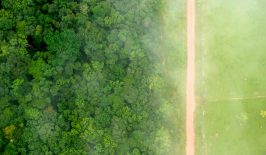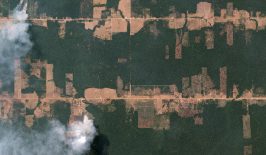Amnesty International’s Decoders programme is tackling major large-scale investigations into human rights and environmental abuses – powered by thousands of digital volunteers around the world. RESET spoke to Amnesty Decoders manager Milena Marin to hear about the evolution of their ‘Decode Darfur’ project in Sudan, and how now they’re using AI to expand their reach.
Ongoing conflict in the Darfur region of West Sudan has impacted over 3 million inhabitants since 2003, with recent reports stating that the government had even used chemical weapons in systemic attacks against civilians. In 2016, Amnesty International started tracking the damage inflicted on villages in Darfur within its Decoders project: a volunteer-led initiative that RESET reported on back in 2018 when they were using documents and images to identify environmental damage caused by oil spills around the Niger Delta.
The Decoders programme invites online volunteers to become digital human rights activists by helping Amnesty International researchers sift through huge amounts of digital information, discover actionable data that evidences human rights abuses and support the organisation’s campaigns. With data coming in from a growing array of sources – from social media messages to satellite imagery and aerial photographs – the Decoder volunteers have a vital role to play in making sense of it all.
The current ‘Decode Darfur’ project has a team of global online volunteers sorting through satellite imagery of Darfur to help trace attacks over time and find evidence that civilians have been systematically attacked. So far, volunteers have made it possible to analyse this vast amount of photographic data by breaking it down into more easily-managed ‘chips’. Assisted by training from a straightforward online demo, the programme is accessible to anyone who owns a digital device, and the 6000+ volunteers working on the project come from all over the world. And now, with the support of machine learning, the Decode Darfur project is on a mission to trace the impact of the violent conflict across the entirety of Sudan.
Why Amnesty started using AI
When Amnesty International started documenting conflict in Darfur, they first needed to locate and identify each village in the region, as Sudanese populations hadn’t been accurately mapped before. This required Amnesty to look for certain characteristics (like straight lines or recurring formations) across thousands of close-up satellite images to figure out where there was human presence. In the second part of the project, Decoders then compared aerial photos of those villages with images from later years to pinpoint when and where civilian communities had been destroyed. This was only made possible with the help of volunteers, as Milena Marin, leader of the Decoders project, explains. “Although we have some image analysts, we never analyse at massive scale—so this was a first in that respect. However, we were still limited by the number of volunteers we could engage.”
The decision to make more of Amnesty’s ‘Decode Darfur’ data came from a meeting with ex-Google employee Julien Cornebise in 2016. Marin recounts how, at the time, Cornebise said, “‘I think you’re sitting on a goldmine of data, and if you were able to train volunteers to do these tasks, you should be able to train an algorithm as well.’” He suggested using the data from volunteers’ training experiences to help the process of machine learning. For the next two years, Marin worked together with Cornebise to make this idea a reality, using algorithms that had been used before by scientists and NGOs, but never in a human rights context.
When Cornebise joined a startup called Element AI in 2018, things started to move more quickly. Prior to that, Decoders had been more limited in their resources, using shots from Google Earth to analyse certain areas in Darfur while in others they relied on public imagery. This didn’t pose an issue for the decoding itself – but accessing data for machine learning was a different story. “We weren’t able to go full blown with the project because we didn’t have the pixels. We needed to download those images and that’s what we couldn’t do,” Marin explains. Once they joined forces with Element AI, Decoders finally gained access to downloadable satellite imagery for their machine learning processes. Because of Element AI – who also helped them improve the accuracy of their new algorithms – the Decoders team was able to move forward with the project. “Now we’re in the testing phase; comparing the accuracy of the algorithm with the expert data.”
In this way, Element AI helped Amnesty Decoders overcome their biggest challenges so far: access to data and researchers. And while Marin is aware that the startup may change the way it conducts pro bono partnerships in the future, for now Decoders are making the most of their support. “The cost of this is usually enormous. We could never afford to pay the full rate of this high-end machine learning in our sector otherwise.”
AI and the Troll Patrol project
Decode Darfur isn’t the only project Amnesty Decoders have used Element AI for. They’re currently also employing the tool as part of their Troll Patrol initiative, which has volunteers scanning tweets aimed at women for toxic or abusive messaging. In this linguistic context, machine learning has a long way to go before it catches up with human accuracy: algorithms scanning tweets for abuse have half the accuracy of human analysts. “There are more nuances involved in understanding language, and sometimes even people don’t get those nuances,” Marin explains.
By way of contrast, satellite imagery is easier for machine learning to identify and differentiate because it’s easier to teach computers about visual rules than linguistic ones. “I think that’s the biggest difference between the two projects,” Marin notes: “their objectivity or subjectivity.” In that sense, the Decode Darfur project is exciting because it shows what might be possible for human rights data analysis once the relevant algorithms have been brought up to scratch. “Computer vision has been developing for a long time now, while natural language processing is much more nascent. Now that language processing is a growing field, we’ll hopefully see accuracy improving over the years.”
Expanding the Decoders project in Sudan
So how might AI change the way Amnesty looks at human rights abuse in Sudan? Primarily, it would allow them to cover much more ground, expanding from Darfur to the entire country. Decode Darfur is already Amnesty Decoders’ biggest project to date, with 6,438 volunteers joining together to map and differentiate 326,000 square kilometers of conflict there. But using machine learning would extend the potential of the project’s already-strong volunteer base. AI would make it easier to process the vast amounts of data found by Amnesty’s researchers and investigators.
Marin tells RESET that, while challenged by limited budgets and partnerships with companies who have other commercial priorities, Decoders have still been making progress with AI. They now have a research paper under their belt (although a human rights risk assessment prevented them from publishing it in case the data fell into the wrong hands and further endangered Sudanese populations). “We don’t necessarily want to give the Sudanese government a hit list, like: “you missed this spot, and this spot…!” Marin points out.
And what about the human side of Decoders? It’s clear that the volunteers both enjoy and excel at their shared projects—could AI replace them at some point in the future? “I don’t think we’ll ever stop using volunteers,” Marin says. “It’s in our DNA. That’s what Amnesty is here for: to engage large amounts of people. And as good as technology is these days – we’ve heard what algorithms can do! – volunteers are much better and faster, and they have purpose.” For Marin, using AI and machine learning is not about replacing volunteers, but supporting them in a symbiotic relationship. “Ultimately we want to have a combination of both. We’ve just got to a stage where we can use the data from our volunteers as training data for the AI. It would be great to do it the other way around, too: to start with the AI data and have machine annotations checked by volunteers.” In this sense it seems that AI can supply functionality at scale, whereas the human contributors provide depth.
At the end of the day, Marin stresses the importance of the project’s community. Having gone from 2,000 to 20,000 members, it was the Darfur group that prompted Amnesty to open up an online forum where its members could discuss their findings with one another. To Marin’s surprise, “people started talking like crazy. We had thousands upon thousands of conversations on the forum.” So they invited the most active members to moderate as well, and found that people were more than happy to do so. “It was really incredible to see how community members who started out receiving an email or reading a tweet ended up becoming capable moderators with Amnesty.” With this in mind, it’s both understandable and reassuring to hear that human contributions will remain at the Decoder project’s core. Meanwhile, AI will make it easier for Amnesty to take their volunteers’ passion and commitment even further.
This article is part of the RESET Special Feature “Artificial Intelligence – Can Computing Power Save Our Planet?” Explore the rest of our articles in the series right here.






